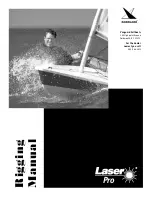
36
OPERATION
Pre-Operation Inspection
NOTE:
Detailed instructions for how to perform the procedures in the inspection chart are contained on the
following pages.
Item
What To Do
Bilge
Drain water from the bilge before
placing the watercraft in the water.
Drain plugs/bilge
Inspect; clean; be sure each plug is
tight, secure and doesn’t leak.
Fuel/oil levels
Check levels of fuel and oil (page 40);
add as needed; inspect for presence
of water.
Coolant
Check level, add as needed
(page 80).
Jet pump
water intake
Inspect and remove any debris; en-
sure intake grate is secure; push rear
of craft up and down in the water to
flush sand out of water intake before
starting.
Throttle
Check for proper operation.
Steering
Check for proper operation; inspect
control cable.
Fire extinguisher
Inspect condition/expiration date.
Item
What To Do
Battery
Check fluid level/condition; vent hose
must be clear and open.
Switches/buttons
Check for proper operation.
Lanyard cord/stop
switch
Check condition and operation.
Loose parts/hoses
Inspect for loose parts/hoses and
connections; tighten as needed.
Hull
Inspect hull for damage or cracks;
clean off any marine growth.
Storage
compartment
Check and secure latches.
Engine cover (seat) Remove and ventilate engine
compartment before starting
engine. Secure seat latches.
Loose ropes/
straps/clothing/long
hair
Be sure that there are no loose ropes,
straps, clothing, etc.;
Long hair is tied back and secured.
Riding gear
Check operator and passenger for
complete gear and proper fit.
Reverse System
Check for proper operation.
https://www.boat-manuals.com/
















































